Pneumatic valve actuators are essential components in controlling the operation of valves within industrial systems, particularly where quick response times and energy efficiency are required. The basic working principle behind pneumatic valve actuators is straightforward: compressed air enters the actuator, driving the piston. This, in turn, generates motion that actuates the valve stem, either rotating or lifting it depending on the valve type. There are two primary types of pneumatic actuators: single-acting (spring return) and double-acting actuators. Understanding the differences between these two types and their working principles is crucial for selecting the right actuator for a given application.
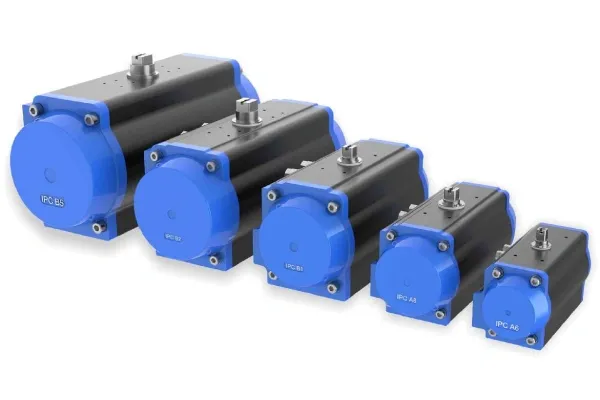
A single-acting pneumatic actuator operates using compressed air and a spring. The actuator can have two configurations: normally open (NO) or normally closed (NC). The configuration determines how the valve behaves when air is supplied to the actuator.
Normally Open (NO): When air enters the actuator, it drives the piston outward, closing the valve. Once the air pressure is removed, the spring forces the piston inward, opening the valve.
Normally Closed (NC): In this configuration, when air enters the actuator, it moves the piston outward, opening the valve. When the air supply is cut off, the spring compresses and moves the piston back inward, closing the valve.
Single-acting actuators are ideal for applications where a return action is needed automatically after the air supply is lost. They are commonly used in systems that require fail-safe operation, where the valve should return to a default position when the air supply is lost.
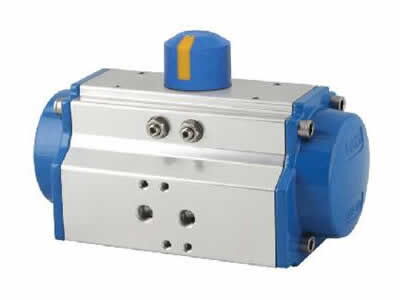
Unlike single-acting actuators, double-acting pneumatic actuators require an external 5-way, 2-position solenoid valve to control the airflow direction and to regulate the opening and closing of the valve. These actuators can both open and close the valve using compressed air, offering more control over the operation.
Operation: In a double-acting actuator, the air supply is alternated between two ports (Port A and Port B) to control the movement of the piston. Air directed to one port moves the piston in one direction, while air directed to the other port moves the piston in the opposite direction.
Speed of Operation: Double-acting actuators typically offer faster opening and closing speeds compared to single-acting actuators because both actions (opening and closing) are powered by the air supply, eliminating the need for a spring return mechanism.
Double-acting actuators are particularly useful in systems where precise control over the valve's position is needed, and where both opening and closing actions need to occur quickly and efficiently.
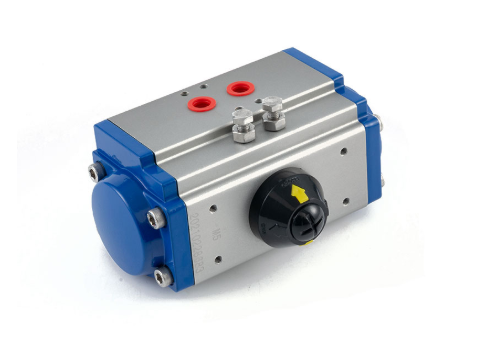
A single-acting actuator uses a spring and a piston to move the valve stem. The operation of a single-acting actuator can be described as follows:
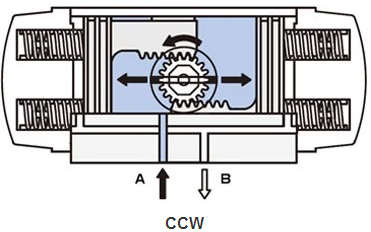
When compressed air enters port A, it forces the piston outward, compressing the spring. This causes the pinion to rotate counterclockwise. As the air is exhausted from port B, the valve moves toward the closed position (in the NO configuration) or the open position (in the NC configuration).
If the air pressure on port A is lost, the energy stored in the spring forces the piston inward, which causes the pinion to rotate clockwise. As the air is exhausted from port A, the valve returns to its default position (either open or closed depending on the configuration).
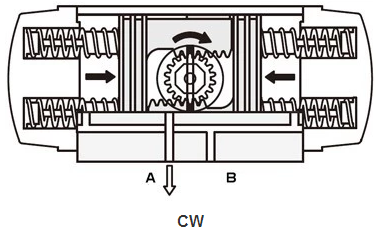
When air enters port B, it forces the piston outward and compresses the spring, causing the pinion to turn counterclockwise as air is exhausted from port B.
If the air supply is lost on port A, the spring forces the piston inward, causing the pinion to turn clockwise and the valve to return to its default position.
This simple mechanism ensures that when air supply is lost, the spring automatically returns the valve to its predetermined position, either open or closed, depending on the configuration.
The double-acting pneumatic actuator relies on two ports, A and B, to control the movement of the piston. Air is directed alternately to these two ports, enabling precise control of both opening and closing actions:
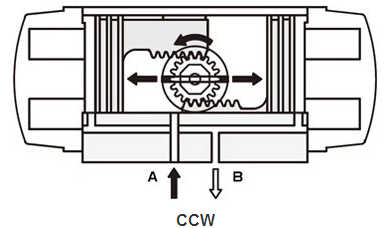
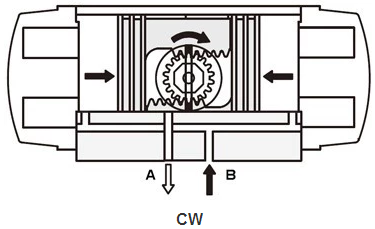
When air is supplied to port A, it pushes the piston outward. The pinion connected to the piston turns counterclockwise while the air is exhausted from port B. This causes the valve to open.
When air is supplied to port B, it forces the piston inward, causing the pinion to rotate clockwise while air is exhausted from port A. This closes the valve.
When air is directed back to port A, the piston is again forced outward, and the pinion turns counterclockwise while the air is exhausted from port B.
Similarly, when air is directed to port B, the piston is pushed inward, turning the pinion clockwise and closing the valve while the air is exhausted from port A.
The advantage of double-acting actuators is that they provide full control over the valve’s opening and closing actions without relying on a spring for return movement. This makes them suitable for more complex systems where precise control and high-speed operation are required.
Both single-acting and double-acting actuators offer distinct benefits depending on the requirements of the application:
Simpler design and operation.
Requires less compressed air compared to double-acting actuators.
Ideal for fail-safe applications where the valve should automatically return to a default position when air pressure is lost.
Slower response times due to reliance on the spring return mechanism.
Requires external solenoid valves to control the direction of airflow.
Faster operation and response times compared to single-acting actuators.
Provides greater control and precision, suitable for complex applications.
Uses more compressed air as both the opening and closing actions are powered by the air supply.
The selection of the appropriate pneumatic actuator depends on several factors:
If the system requires fail-safe operation, such as for emergency shutdown applications, a single-acting actuator with a spring return is ideal. However, if speed and precise control are needed, a double-acting actuator may be the better choice.
Double-acting actuators generally offer faster valve operation, making them suitable for applications that require rapid response times, such as in automated or high-speed processes.
Single-acting actuators are more efficient in terms of air consumption as they only require air to operate in one direction. Double-acting actuators require a constant air supply to both ports, which may require a larger or more efficient air compressor.
For smaller, simpler applications, a single-acting actuator is usually sufficient. However, larger, more complex systems benefit from the increased control provided by double-acting actuators.
Pneumatic valve actuators are vital components in many industrial systems, enabling efficient and reliable control of valves. The choice between a single-acting (spring return) actuator and a double-acting actuator depends on factors such as speed, control, air supply, and the complexity of the system. Understanding the working principles of each actuator type helps ensure the proper selection and optimal performance of pneumatic valve systems in various applications. Whether you are designing a simple on-off control valve system or a complex process that requires rapid and precise valve control, selecting the right actuator will enhance system performance and reliability.
